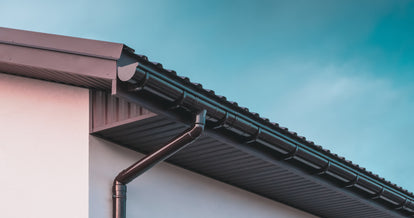
Guttering and Downpipe Guide
Posted on 05 July, 2021

What parts are used to construct the guttering on a property? We explain the elements required for a working gutter and downpipe system.
Stopend – External
An external stopend is placed at the end of the guttering and finishes the run of the length. It prevents the water from draining off the edge of the gutter, diverting it in the other direction to be drained.

Gutter
The gutter runs along the length of the roofline. It catches and carries the water along the guttering towards the downward drainage point.

Fascia Bracket
Fascia brackets are fixed to the fascia and help to hold the gutter length in place. This prevents the likelihood of potential breakage from harsh windy weather conditions. The gutter is then slotted into the bracket and held in place.

Angle Bend
An angle bend is placed at the corner of the property where the two points meet. They help join two connecting gutter lengths around corners and at bends on the building.

Union Bracket
A union bracket is used to connect two different parts of the gutter securely together. Union brackets feature a fitted gutter seal with a retaining clip that allows for easy installation on most materials and types of guttering.

Running Outlet
The running outlet features a downward spout in the middle. This connects to the gutter length and allows the water to drain down the spout and into the drain pipe which is connected to the offset bend.

Stopend – Internal
The internal stopend is similar to the external stopend. It is placed just after the running outlet to prevent water from draining off the end of the gutter length, helping to divert water towards the running outlet and down the drain pipe.

Offset Bend
The offset bend is connected to the running outlet. This is where the gutter begins to connect to the downpipe in which the water runs through from the gutter length to the drain pipe. Two offset bends are normally used and connected together.

Downpipe
The downpipe is connected to the offset bends and carries the water down towards the bottom of the pipe length, which is directed towards the ground.

Pipe Socket
A pipe socket is located along the downpipe and connects two different pieces of downpipe together. One side of the pipe socket features fixing lugs which are secured to the wall of the property. This helps keep the downpipe in place, helping prevent movement or damage from wind or harsh weather.

Pipe Clip
The pipe clip is placed around the downpipe and features fixing lugs which help to keep the pipe fastened to the wall of the property. These are placed at points along the downpipe to prevent harsh weather from moving the drain out of place.

Shoe
The downpipe shoe is placed at the very bottom of the drain pipe and is connected to the downpipe. It features a bent or rounded outlet which allows the water to leave the pipe. This is directed into an outdoor drain or gutter.

UPVC guttering and downpipe is a long lasting, highly durable option when it comes to purchasing parts for your roofline drainage system. With a choice of rounded, squared, cast iron effect and ogee guttering available, allowing you to choose your preferred look to compliment the exterior of your home.